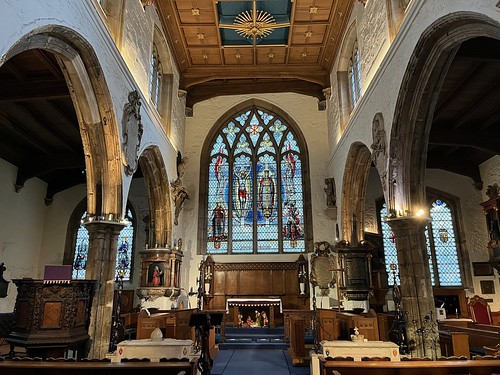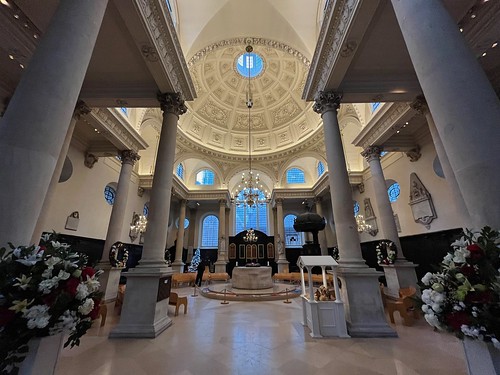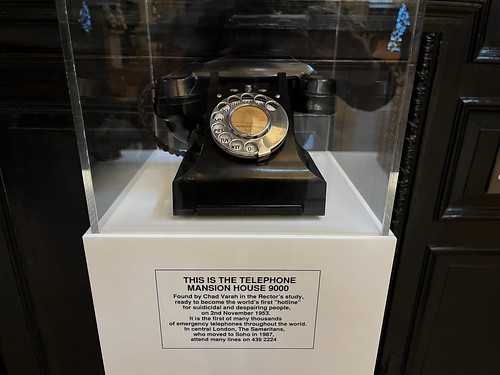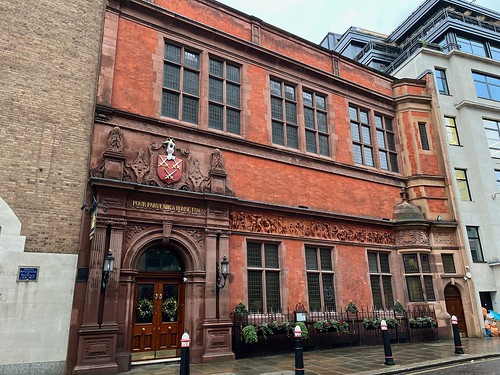Sometimes you make a plan, and sometimes that plan falls by the wayside. This was the case on a recent Monday morning just before Christmas. I'd been in Southend-on-Sea for a very jolly Christmas Party the night before, and then for a group breakfast by the seaside the morning after (Salmon Bubble Stack, since you asked). I also had plans in the West End that evening, and since Southend-on-Sea is in the far southeast, and the mooring for the boat is in the far northwest, it wasn't really practical for me to get all the way home to the boat and then all the way back to the West End in time for my rendez-vous. Despite having not even started packing for my Tuesday flight home to Canada for Christmas, and even though there was a lot to be done on the boat otherwise (more on which later, if I can bear to recount the sad tale) I decided that sometimes you just need to let fate intervene. So on the train back towards central London I made a plan to visit one or more small London museums, most probably the Freemason's Hall, as a pleasant diversion to fill the time before my evening engagement.
The train from Southend-on-Sea terminates at Fenchurch Street Station, one of London's smaller rail termini. From there it's a short walk to an Underground station for the journey to Holborn, which would have been maximally efficient, but that's not the kind of mood I was in. Instead I thought I'd walk, since though it was cloudy and threatening, the weather was much warmer than it had been for ages and there was no urgency to my mission whatsoever. Moreover, I decided once again to put away Google Maps and find my own way. So began a meandering journey that should have taken 45 minutes, and ended up clocking in at about three hours and six kilometres. Because, as any Astute Go Stay Work Play Live Reader will understand, if you've got the time to stop and look when you're walking through London, you can't help but see some really cool stuff.
I figured it would be easiest to stay oriented if I was closer to the river, so I turned that way down a small side street near Fenchurch Street and was quickly distracted by the entrance to a nearby church - St.Olave's. And this perfectly illustrates my point about the density of cool stuff in London. Just by chance, less than a hundred metres from my starting point, I'd found one of the only medieval-era churches in the City of London to survive the Great Fire of 1666, which is also the final resting place of the famous diarist, Samuel Pepys.
This version of St. Olave's (named for the Norwegian saint) was built around 1450, though there was a house of worship on the site from about 1050. (So that's less than a thousand years. Pfft.) The churchyard is quite nice too. Small but pleasant, with a mosaic labyrinth and a stone entryway dubbed the Ghastly Grim Gate (by Charles Dickens, of course) because of the tympanum of the gate features carved skulls. That gateway leads onto the melodiously-named Seething Lane.
From Seething Lane I turned west and south again before walking down St. Mary at Hill street. This time I didn't bother visiting the eponymous church, though I did linger outside Waterman's Hall, the home of The Company of Watermen and Lightermen of the River Thames, a livery company. From there, a slight deviation to the northwest brought me to The Monument. (Which really deserves its own blog, so I'll just mention that I thought it fitting that a fire truck went past as I was reading one of the inscriptions on the base of the column.) Notably, one of the designers of The Monument was Sir Christopher Wren, who has, of course, been mentioned in the blog several times before and who will feature again very shortly. But first, I headed towards an often-overlooked landmark near Cannon Street Station.
It's believed this unassuming lump of oolitic limestone has sat at or near this spot (barring a few relocations for safekeeping) since (they think) the Roman era (maybe). And you can take my multiple parentheses as an indication of how little is definitively known about the stone. Most of its history is myth and conjecture, though it does definitely appear on the Copperplate Map of London from the 1550s. This fancy Portland stone enclosure is very new - completed in 2018. I fondly remember its former, much less grand home behind an unassuming cast iron grill at street level, which made it look more like a storm drain than the resting place of a (possibly) ancient and (sort of) mystical (-ish) artefact.
By this point it was becoming clear that the goal of visiting Freemason's Hall was fading fast and my afternoon was going to be spent in an aimless but diverting and fruitful wander through London, an idea that I wholly embraced en route to my next diversion, a dome that I spotted over the rooftops a few streets away and seemed worth a look.
The plaque outside indicated that St. Stephen's was another effort of Sir Christopher Wren, but even if I hadn't been told that I'd like to think I would have recognised this right away as a Wren church. Characterised by rounded arches and white walls, Wren's churches are a marked departure from the darker gothic style you can see at St Olave's. Apparently St. Stephen's was Wren's parish church, so he took particular care with it, crowning it with what some consider his finest dome. In all, Wren was commissioned to rebuild 51 churches after the Great Fire, of which 13 survive in their original form, St. Stephen's among them.
And because it's London and the history is laid on with a trowel, inside the church there was also this:
I lingered for a while at St. Stephen's, before wending my way past the Mansion House and the Bank of England, stopping to read this plaque set in the pavement.
And then, of course, there was another church. Another Wren Church.
St Mary le Bow is the home of the famous Bow Bells. I've said it before but just for clarity (and word count), the Bow Bells are significant because a true Cockney must be born within the sound of their peal. Wikipedia helpfully notes that in 1850 the sound of the Bow Bells could likely be heard as far as Hackney Marshes, Limehouse and possibly even south of the Thames in Southwark. Tragically, urban noise pollution and the lack of any maternity hospitals in the vicinity make the birth of any genuine 21st century cockneys unlikely (though not impossible).
The Bow Bells also feature in the famed nursery rhyme "Oranges and Lemons" a Who's Who of London churches:
Oranges and lemons. Say the bells of St. Clement's.You owe me five farthings. Say the bells of St. Martin's.When will you pay me? Say the bells at Old Bailey.When I grow rich. Say the bells at Shoreditch.When will that be? Say the bells of Stepney.I do not know. Says the great bell at Bow.Here comes a candle to light you to bed,And here comes a chopper to chop off your head!Chip chop chip chop the last man is dead.
Next up were a few more livery halls - the Saddler's Hall and the site of the former Broderers Hall ("formed to promote and protect the fine art of embroidery"). And of course I wouldn't make it out of the City without another Wren church, this one the oddly named St Vedast-Alias-Foster, which sounds more like a What Three Words location than a place of worship. (For the record, one of the What Three Words locations covered by St Vedast is Sleepy.Covers.Fantastic.)
St Vedast-Alias-Foster follows the formula of so many City churches: founded in the middle ages, damaged or destroyed in the Great Fire, rebuilt by Wren, bombed during the Blitz, and restored once again in the 1950s. Interestingly, this church was Wren's most economical effort, built up from the medieval foundations for a mere £2,958, as compared to a whopping £15,421 for St. Mary le Bow. (Only St. Paul's Cathedral was more expensive.)
St. Paul's was just down the street, but having been there before I skipped that most obvious of Wrens, past a gigantic construction site of what looks like it's going to be an awful lumpish office development just behind the cathedral. The last Wren site of the day was the former Christ Church Greyfriars which follows the above formulas up to the point of its substantial destruction in the Blitz. The outer walls and tower survived, and today surround a public garden. The nearby vestry building is now home to a dentist's office. Of course.
A brief diversion down Warwick Lane lead to the Cutler's Hall (another livery company) that boasts a really lovely terracotta frieze by Benjamin Creswick, depicting the different steps in the process of knife-making: forging, grinding, hafting, and finishing.
Nearing the home stretch, and now slightly damp with intermittent drizzle, I headed along Fleet Street, famously the home of the printing trade and, by extension, to newspapers and journalism. Printing started in the area around 1500, and the first newspaper was published there in 1702. Dickens Pickwick Papers is partially set on Fleet Street and it's also the home of the equally fictitious demon barber. This was familiar territory, since Fleet Street is a major thoroughfare. However, I'd never noticed one laneway off a side street: Magpie Alley
By now it was well past time for cake and a hot beverage, and I was gratified that even though I was still navigating by feel, it wasn't long before I found my way to High Holborn Street, and a nice cup of tea. I did also eventually end up going past my originally intended destination - Freemason's Hall - but we'll have to save that for a whole other blog because by that time I was in very familiar territory and on my way to something even better than a nice cup of tea... a friendly few pints in a nice pub!
That was just one relatively short walk on a quiet Monday afternoon, with no overarching theme or purpose, that still managed to take in what I think is an astonishing number of unique or beautiful or quirky sites. Because... well, because it's London. And more than twelve years after I arrived, and nine years after I wrote this, I still love it.














0 Comments:
Post a Comment